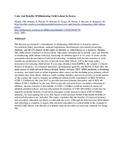| dc.identifier.citation | Manda, DK, Kimalu P, Nafula N, Kimani D, Nyaga R, Mutua J, Mwabu G, Kimenyi M. 2003. Costs and Benefits of Eliminating Child Labour in Kenya. KIPPRA. | en |
| dc.description.abstract | The Kenyan government’s commitment to eliminating child labour is stated in various Government policy documents, national legislations, international conventions protecting children, and the UN charter on the rights of children, to which Kenya is a signatory. Despite this, child labour continues to be prevalent.
This paper estimates the economic costs and benefits of eliminating child labour in Kenya, focussing on children aged 6 to 14 years. It works on the assumption that the provision of universal schooling, combined with income transfers to poor families to compensate for the loss of income from child labour, will be the main policy instrument for reducing child labour. It uses data obtained from KIPPRA, the country’s Central Bureau of Statistics, Government ministries, international agencies, and NGOs.
It finds that:
the main causes of child labour in Kenya include family violence, HIV/ AIDS pandemic, a declining economy, and rapid rural-to-urban migration
other causes are the declining gross primary school enrolment rate, intra-ethnic violence, cattle rustling, banditry and severe poverty in some regions of the country
the country requires an additional annual public expenditure of KES 30 billion (USD 1.2 billion) by the year 2015 to provide universal primary education, and of KES 40 billion (USD 1.6 billion) by the year 2020 to provide universal lower secondary education
in addition, income transfers to households of USD 1.4 billion would be needed to ensure all children attended school, and non-educational investments of USD 300 million would also be required
economic benefits of universal education would amount to about USD 83 billion annually, far outweighing the costs; this figure would increase further if the health benefits of universal education were included.
The paper concludes that the benefits of universal primary and secondary education are likely to outweigh the costs. Although the link between child labour and schooling is complex, it argues that universal education is a central pillar in the struggle to abolish child labour, and that the cost benefit analysis provides an economic rationale for doing this. | en |

